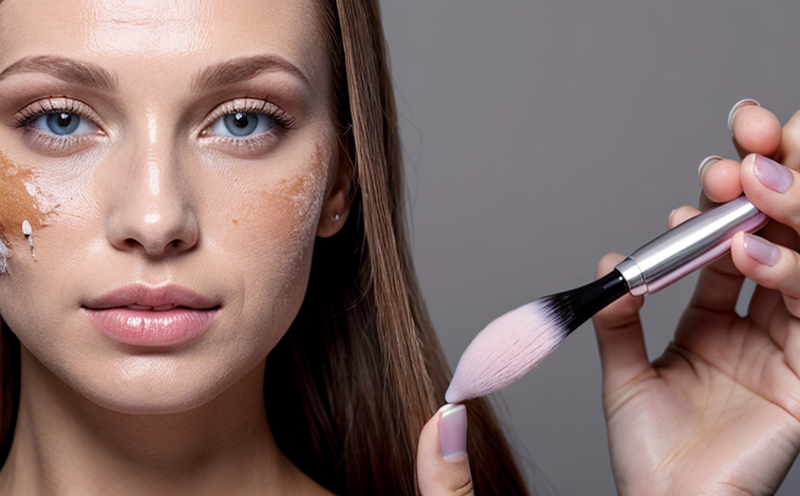EU Labeling Requirement Testing in Cosmetic Products
The European Union’s stringent labeling requirements for cosmetic products are designed to ensure consumer safety and protect public health. Compliance with these regulations is not only a legal requirement but also a critical step in maintaining market access across the EU member states. The primary directive governing this area is EU Regulation (EC) No 1223/2009, which mandates that all cosmetic products placed on the market must be clearly labeled with specific information.
These labels are required to contain details such as the product’s name, ingredients, and contact person. The regulation also specifies the need for certain warnings or cautions if a product contains substances known to cause allergic reactions or other adverse effects. This mandatory labeling ensures that consumers have accurate and transparent information about their purchases.
To achieve compliance, cosmetic manufacturers must undergo rigorous testing procedures. This includes not only chemical analysis but also microbiological assessments to ensure the safety of ingredients and final products. The tests are conducted in accordance with international standards such as ISO 21778 for allergen identification, ASTM D439 for colorfastness testing, and IEC 60272 for packaging safety.
The process of ensuring compliance involves multiple steps. Initially, the product formulation is evaluated to identify all ingredients and their potential interactions. This stage often requires advanced analytical techniques such as High Performance Liquid Chromatography (HPLC) and Gas Chromatography-Mass Spectrometry (GC-MS). Once identified, these ingredients are tested for allergenicity using in vitro methods like the EpiDerm test.
The testing process also includes evaluating the stability of the product over time. This involves storing samples under various conditions and assessing changes in formulation over extended periods. Stability tests are critical for ensuring that products remain safe and effective throughout their shelf life, which is typically defined by the manufacturer but cannot exceed five years.
Another crucial aspect of compliance testing is the evaluation of packaging materials used in cosmetic products. Packaging must not only be aesthetically pleasing but also ensure the safety and integrity of the product inside. This includes tests for material compatibility with the contents, preventing contamination, and ensuring that containers are suitable for the intended use.
Finally, all test results are compiled into a comprehensive report detailing the compliance status of each cosmetic product. This document serves as proof that the manufacturer has met all regulatory requirements and is ready for market distribution.
- Customer Impact and Satisfaction: By adhering to these stringent labeling requirements, manufacturers can build consumer trust through transparency and safety assurances. Satisfied customers are more likely to recommend products, leading to increased brand loyalty and sales growth.
- Environmental and Sustainability Contributions: The focus on ingredient purity and product stability also contributes positively to the environment by reducing waste from unsatisfactory or expired products. Additionally, testing for sustainable packaging materials supports the broader goal of environmental conservation.
Scope and Methodology
The scope of EU labeling requirement testing in cosmetic products is broad, covering a wide range of parameters to ensure that all aspects of product safety are addressed. The methodology involves several key steps:
- Initial Ingredient Identification: This step begins with the comprehensive list of ingredients provided by the manufacturer. Each ingredient undergoes detailed analysis using advanced analytical techniques.
- Allergen Testing: For products containing known allergens, in vitro testing is performed to assess potential reactions. The EpiDerm test is particularly useful for this purpose.
- Stability Testing: Samples are stored under various conditions over extended periods to evaluate changes that might affect product safety and efficacy.
- Packaging Evaluation: Packaging materials are tested for compatibility, integrity, and suitability for the intended use. This includes ensuring that the packaging does not react with the contents in a harmful way.
The methodology is designed to be thorough yet efficient, allowing manufacturers to meet regulatory requirements while maintaining operational efficiency. Compliance testing is an ongoing process, requiring regular updates as new regulations or scientific advancements emerge.
Customer Impact and Satisfaction
- Increased Consumer Trust: By adhering to strict labeling standards, cosmetic manufacturers can build strong relationships with their customers. Transparent and accurate labeling fosters trust and confidence in the brand.
- Positive Brand Image: Compliance with EU regulations enhances a company's reputation for quality and integrity, which is essential in today’s competitive market.
- Enhanced Consumer Safety: The rigorous testing process ensures that products are safe for use by consumers. This reduces the risk of adverse reactions or other safety concerns.
- Market Access: Compliance with EU labeling requirements opens doors to sell products in the European market, which is one of the largest and most lucrative markets globally.
In addition to these benefits, compliance testing also helps manufacturers identify areas for improvement. This proactive approach ensures that any potential issues are addressed before they impact consumers or the company’s reputation.
Environmental and Sustainability Contributions
- Promoting Sustainable Packaging: The focus on packaging materials contributes to reducing waste by ensuring that only sustainable options are used. This reduces the environmental footprint of cosmetic products.
- Minimizing Resource Consumption: By ensuring product stability, manufacturers can reduce unnecessary production and testing cycles, thereby minimizing resource consumption.
- Avoiding Contamination: Packaging materials that prevent contamination help to maintain product quality and safety, thus reducing the need for replacements or recalls.
The rigorous testing process not only ensures compliance with EU regulations but also promotes sustainable practices within the industry. This dual approach enhances both customer satisfaction and environmental stewardship.





